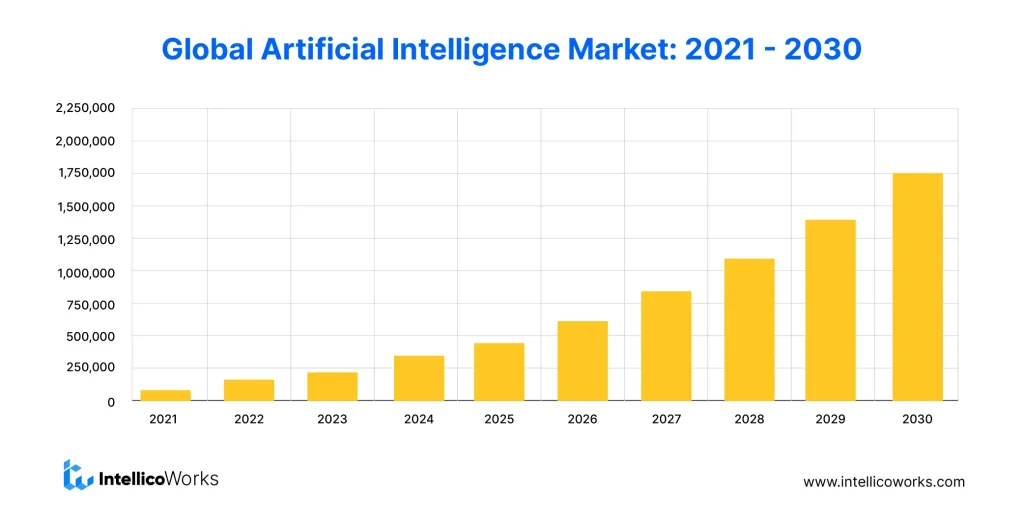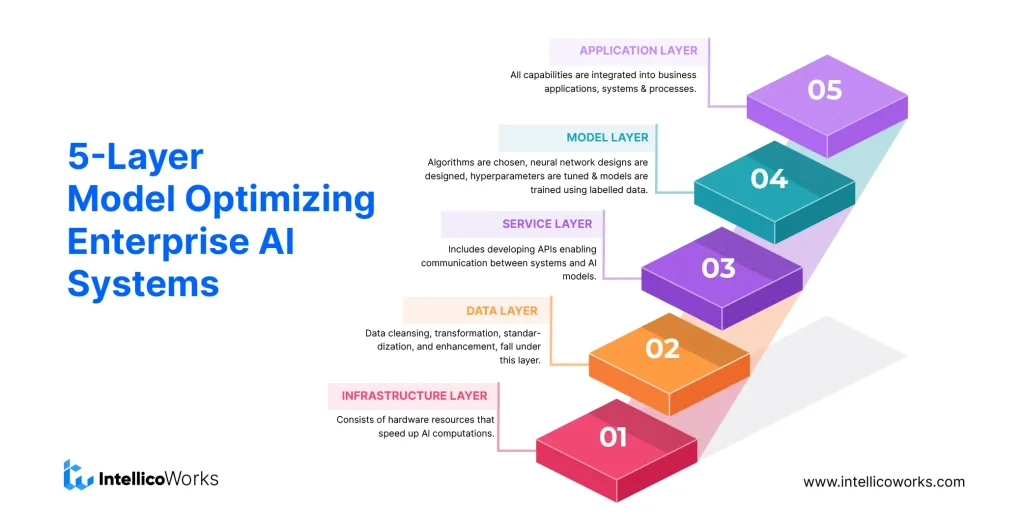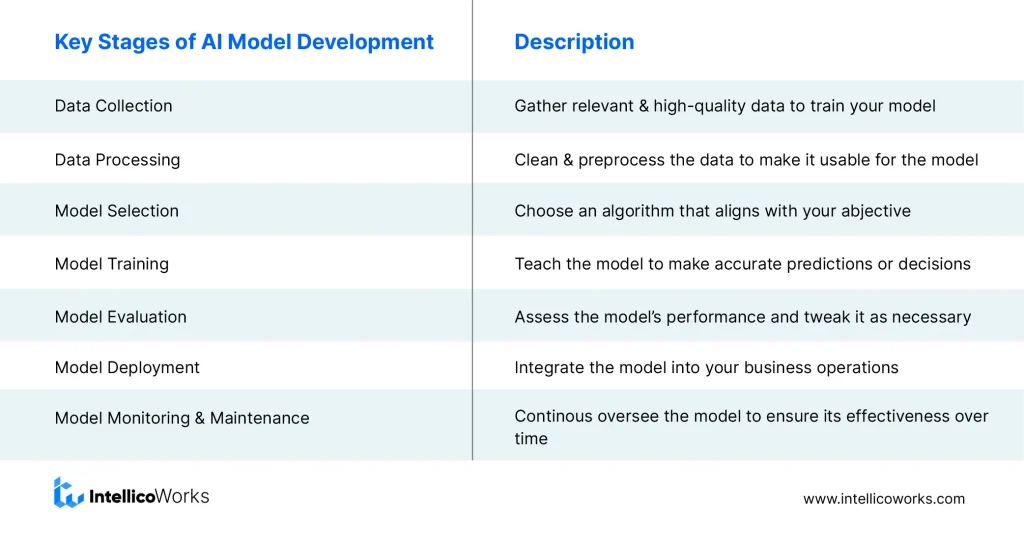When teams operate independently, it creates communication gaps that can lead to disorder. In contrast, when teams collaborate, they tend to be more efficient.
Have you ever thought we would live in a world where machines mimic humans? Looks like a sci-fi movie, right?
With the rapid advancements and developments in AI, data, clever algorithms, and AI models are changing how businesses operate. The right-crafted AI modeling can even augment human capabilities with great precision. AI models can help you overcome the most complex business challenges. Artificial Intelligence is not just hype, it already transformed businesses in industries like finance and healthcare. If you want your business to thrive, find the key to how to create an AI model for your enterprise.
In this blog, we will answer how to build an AI model that will enable your enterprise to become more functional, secure, and profitable.
According to Statistica, the current global AI market is worth around $100 billion and is expected to be close to $2 trillion by 2030. Investing and creating an AI model today is a golden ticket to future-proof your business.
This growth is attributed to the myriad of industries that have already integrated AI into their operational systems. Notable developments include the rise of chatbots, image-generating AI, and other AI-based mobile applications, which make the future of artificial intelligence a promise. Let’s explore how to create an AI model for enterprises and uncover how the Five-Layer Model optimizes enterprise AI systems for impressive efficiency, innovation, and success.

AI Model is an intelligent sophisticated system having extreme cognitive capabilities. AI models can process vast amounts of data by predictive analytics of patterns to make data-driven predictions. AI training models can perform the most difficult tasks with accuracy. This is what makes AI data modeling as efficient and reliable as human intelligence.
Just like the human mind an AI foundation model keeps learning and becoming better and better. The core technologies of the AI model are neural networks. It operates through a series of complex algorithms and has neural networks incorporated. It learns from labelled data, deriving relevant insights and building internal representations. After training it enters the inference phase. In this phase, it leverages the insights and gets trained to make predictions or classifications when presented with new data. However, this process isn’t static. With continuous feedback, the AI model refines its abilities over time, ensuring ongoing improvement and relevance. And it becomes more and more efficient over time.
Examples include ChatGPT or Gemini. These AI language models produce human-like text in response to human input. They can identify objects, individuals, and situations represented in images. This proves the capabilities of AI model efficiency.
AI models are mathematical frameworks that are designed to mimic human intelligence. To create an AI model, it is essential to enable machines to perform tasks that typically require human intelligence, such as understanding natural language, recognizing patterns, making decisions, and solving complex problems. Here’s a list of different AI models that use different AI tech stack:
Developing AI for businesses requires careful coordination of systems. If enterprises want to maximize efficiency, architects frequently should utilize a multi-layered strategy. The 5-layer AI Model stands out as a model of innovation and provides an excellent framework for realizing the full potential of AI in companies. Get to know the structure and applicability of the AI model before understanding how to make an AI model:

The infrastructure layer works as the foundation of generative AI architecture for enterprises. It provides computing power for rapid AI tasks. It consists of hardware resources like servers and GPUs. These resources enable data processing and analysis. There are two types of infrastructures; easy-to-scale and easy-to-adopt. Businesses can choose from these alternatives on cloud platforms like AWS, Google Cloud, and Azure to ensure efficient data processing and analysis.
The data layer is also known as a warehouse. it stores raw materials collects stores, and organizes data for AI tasks. This organized data includes customer information and manufacturing process sensor data and undergoes pre-processing phases like refining, transformation, and standardization to maintain usability and quality. Data warehouses are commonly used to manage large volumes of data efficiently.
It is the phase where we deploy AI models so it can start working as a service layer. This layer is like a delivery system, bringing final products from the factory to customers. In the context of AI, it enables the system to effectively manage and deploy these models.
In addition to creating application programming interfaces or APIs, there is a need to enable different systems that communicate with AI models. It involves activities including scaling, monitoring, and model deployment. Architectures with containers and microservices are often used to speed up deployment and management.
Here starts the process of creating and training the AI models. This phase includes data scientists and engineers. They choose algorithms and architect neural network architectures with labeled data at the model layer. Moreover, the models are developed to learn and improve over time through the use of techniques like optimization and hyperparameter tuning. Data engineers use popular machine learning frameworks in this layer like PyTorch and TensorFlow.
At last, We test the AI model to work in real-world scenarios, therefore the final layer- the application layer comes into play. The application layer needs the integration of AI into business applications, systems, and processes. This may involve using AI-generated predictions to optimize supply chain operations, recognizing the frauds in financial transactions or personalization for customer/user experience, and more. The aim is to utilize AI insights to make informed decisions and drive results for business.
Using a step-by-step guide to custom AI model development is very efficient. This section will highlight the key steps of building AI models for enterprises:

The effective integration of an AI model includes some necessary steps like identifying the issues that need to be resolved. These issues can vary from operational efficiency to increasing revenue or enhancing customer satisfaction.
After creating documentation of drawbacks, gather and prepare data to boost your AI model’s performance. Then, thoroughly test it using high-quality datasets that accurately represent real-world scenarios. Data sources include internal databases, third-party vendors, and IoT-enabled devices.
This is the most important step to build a custom AI model for enterprises. Start by selecting the right algorithm and model architecture. You should consider aspects like data nature, issue complexities, and computational resources. You can use popular machine learning algorithms like linear regression, support vector machines, decision trees, and neural networks. Always choose a model architecture that is a perfect fit for your use case, whether it’s a simple regression model or a deep-learning neural network.
AI model development involves providing a large amount of example data to the model to train it. AI adjusts its guesses closer to the correct answers. Gradients are calculated to improve the AI’s accuracy, similar to determining the direction to move in a game. Developers use powerful computers and AI software like TensorFlow and PyTorch to make the training process faster and more efficient. These tools manage large amounts of data and complex calculations. This way, it allows AI to learn more quickly and accurately resulting in more reliable and better-performing AI models.
Time to assess the model’s performance using validation datasets. AI model efficacy is measured using metrics such as F1-score, recall, accuracy, and precision. However, when the model undergoes continuous refinement it enhances its efficiency and reliability to generate accurate predictions on unfamiliar data, guided by the evaluation results.
After the evaluation results, the dataset is then divided into three subsets: Training, Validation, and Testing. Training data trains the model’s parameters, validation data fine-tunes hyper-parameters. Testing is the major step that you cannot skip during product development and AI model development. The AI development team helps assess the model’s performance using a real-world dataset. If the model meets expectations and delivers desired results, it is ready for deployment.
Building an AI model requires continuous model monitoring & maintenance. This is important for maintaining accuracy and relevance. This holistic and ongoing approach ensures the model’s effectiveness and alignment with changing needs. As a result of collecting user feedback, monitoring performance, and making adjustments as needed, AI models respond effectively to shifting data patterns.
Generative AI technologies are on the boom. The main example is ChatGPT which offers new opportunities for problem-solving, automation, and content creation. Building an AI model app requires meticulous planning and execution, focusing on key pillars like data quality, datasets, and a well-organized data pipeline. IntellicoWorks is an AI development company that is emphasizing the importance of developing a data-driven culture, defining business objectives, curating data, and using the right AI technology. We offer AI development solutions to help businesses harness AI’s transformative power to boost productivity, encourage corporate growth, and stay ahead of innovation.
Building and integrating an enterprise AI model application is a complex but rewarding strategy. It requires planning and execution by understanding unique business needs. Keeping an eye on industrial trends enterprises can leverage AI for sustainable growth. As you know, scalable AI solutions are important to thrive. They can adjust to increased data volumes and expand business needs without compromising on performance. Adapt an AI model system for your enterprise today and continue to deliver value.
Transform Your Vision into Reality with Expert AI Development Solutions!

Talk to us and let’s build something great together
A Subsidiary of Vaival Technologies, LLC
IntelliCoworks is a leading DevOps, SecOps and DataOps service provider and specializes in delivering tailored solutions using the latest technologies to serve various industries. Our DevOps engineers help companies with the endless process of securing both data and operations.
Ops
Cloud
AI & ML
Copyrights © 2023 byIntellicoworks. All rights reserved.